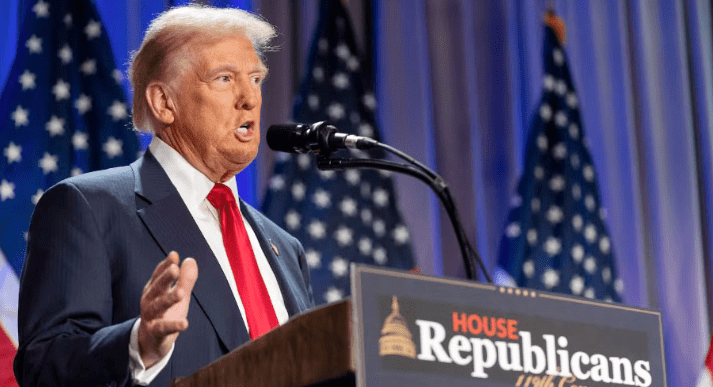Trump’s Tariff Policy: A Threat to the Global Economy? The potential opportunities and risks for forex traders.
In the current global economic context, U.S. President Donald Trump’s tariff policy has become a topic of intense discussion. Particularly, trade relations between the United States, Canada, Mexico, and China have taken a new turn. This has led to significant volatility in the global stock markets and currency markets. In this article, we will discuss the impact of this tariff policy, the potential opportunities and risks for forex traders, and the broader economic effects.
New Dynamics in U.S.-Canada Relations
The U.S. and Canada have historically shared friendly relations, but recent tariff policies have created tension in their relationship. According to the Trump administration’s announcement, tariffs have been imposed on $155 billion worth of Canadian goods. Of this, $30 billion in tariffs will be immediately applied, while the remaining $125 billion will take effect 21 days later.
Canadian Prime Minister Justin Trudeau has strongly opposed this tariff policy and has announced retaliatory measures. As a result, the Canadian dollar (CAD) could come under significant pressure, which is an important signal for forex traders. The tariffs may lead to a reduction in Canada’s foreign currency inflows, which could result in a weaker CAD/USD pair.
U.S.-China Trade War
The imposition of a new 10% tariff on China has prompted Beijing to respond directly and plan to file a case against the Trump administration in the World Trade Organization (WTO).
As China’s economy is heavily reliant on exports, this tariff policy could have a negative impact on its manufacturing sector. Specifically, China’s major index, the FTSE China A50 (CHA50), has already fallen by 0.44%, reflecting investor concerns.
This situation is crucial for forex traders. If China’s currency (CNY) weakens, there may be significant movement in the USD/CNY pair. Additionally, a reduction in China’s production could put pressure on the Australian Dollar (AUD) and New Zealand Dollar (NZD), as these countries’ economies are closely tied to China.
Global Stock Market Reactions
Trump’s tariff policies have also led to volatility in global stock markets:
- U.S. Market: The Dow Jones (US30) fell by 0.75%, S&P 500 (US500) by 0.50%, and Nasdaq (US100) by 0.14%.
- European Market: Germany’s DAX (DE40) rose by 0.02%, France’s CAC 40 (FR40) by 0.11%, and Spain’s IBEX 35 (ES35) dropped by 0.41%.
- Asian Market: Japan’s Nikkei 225 (JP225) dropped by 2.59%, while Hong Kong’s Hang Seng (HK50) rose by 0.91%.
These market movements could have significant effects on the forex market. For example, if investors view the U.S. dollar (USD) as a safe haven, the USD index could strengthen.
Forex Trading Strategies
- Monitor CAD/USD: Due to the impact of tariffs, CAD could weaken, which may create an opportunity to take a long position in the USD/CAD pair.
- Track China’s Economic Reports: If China’s economy continues to weaken, significant movements in the USD/CNY pair may occur.
- Be Cautious with AUD and NZD: Due to reduced production in China, both AUD/USD and NZD/USD could experience weakness.
- Focus on Safe-Haven Assets: Demand for the U.S. dollar (USD) and gold (XAU/USD) may rise, creating opportunities for forex and gold traders.
The Trump administration’s new tariff policy presents significant challenges for the global economy. The trade wars with Canada, Mexico, and China are creating both opportunities and risks for forex traders. From a currency market perspective, CAD, CNY, AUD, NZD, and USD could be the most affected. Therefore, forex traders should regularly monitor these currencies and global economic updates and adopt appropriate strategies.
Mixed Reactions to the U.S. Dollar: Impact of the Fed’s Interest Rate Hints
On Tuesday, following statements by several Federal Reserve officials, the forex market saw a mixed response to the U.S. dollar. The Fed officials hinted that interest rates might be reduced by the end of 2024, putting pressure on the U.S. dollar.
Key Points:
- Dollar Decline: After the Fed’s statements, the Dollar Index (DXY) dropped to 103.20.
- Stronger Euro and Pound: The Euro (EUR/USD) and Pound (GBP/USD) showed some strength against the dollar.
- Gold and Crypto: The anticipation of lower interest rates led to an increase in gold (XAU/USD) and Bitcoin (BTC/USD) prices.
- Equity Market: Stock markets saw slight increases as investors awaited the Fed’s next move.

Important Considerations for Traders
If the Fed does indeed proceed with cutting interest rates, both short-term and long-term traders will need to adjust their strategies. In the short term, the U.S. dollar could weaken, which would be positive for gold, the euro, and other major currencies.
What Traders Should Do:
- Keep an eye on U.S. economic data (CPI, NFP) and upcoming statements from the Fed.
- Gold and cryptocurrency traders may view this as a potential bullish signal.
- Use economic calendars from Forex Factory and Myfxbook to track important news and events.
For traders, this is a crucial time. Stay cautious, plan your trades, and adjust to market changes.
Rana Das, CEO, Forex Wave Expert
Forex Trading, U.S. Dollar, Federal Reserve, Interest Rates, Forex Analysis, Gold Price, Forex News.

Add a Comment
You must be logged in to post a comment